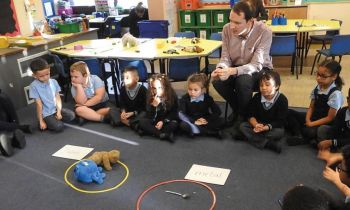Back when I worked in a hospice setting I would often nurse people with children and grandchildren, and became very familiar with the impact of grief and bereavement on children and young people.
I now run workshops for school staff, where I aim to provide a theoretical overview of the key principles involved in loss, while also helping them to explore their own feelings around death and dying.
The sessions tend to be structured around attendees’ desire to enhance their existing knowledge and explore what strategies they can use to support children affected by loss and bereavement. Schools will often have staff appointed to pastoral roles, but they sometimes need to recognise that the support children require won’t always come from pastoral staff. It may be that the child doesn’t want to speak to them, and would feel more comfortable speaking to a teacher they know well. Ideally, all staff across a school should feel confident in offering support to children at a time of grief, rather than it always falling to just one team or section.
Children’s reactions to bereavement can be affected by many factors, such as the nature of the individual’s death or the relationship they had with them. Family units can vary hugely in terms of how they communicate, and children can express grief in a variety of ways, depending on their personality.
Some children might exhibit pronounced changes in behaviour. A child who’s normally quite amenable might start falling out with, or bullying others, for example, though expressing grief can sometimes be a good thing due to the catharsis it brings. Schools perhaps need to be more aware of those children who are quieter and appear to be getting on with things. There can be the assumption that a pupil’s doing well, because he or she isn’t getting upset, being disruptive or showing signs of anger – but that can pose difficulties for the child if they’re bottling everything up inside.
Any efforts to improve bereavement support should involve a whole school approach and giving staff freedom to manage the matter themselves – perhaps by commemorating an individual who’s died as a class by releasing a balloon or performing some other gesture – and allowing some leniency around the school’s standard policies.
For example, children who struggle to verbally express how they feel can be allowed to wear a selection of differently coloured wristbands. Red might mean ‘Today’s not a good day’, amber ‘Not too bad’ and green ‘Today I’m feeling quite good.’ If teachers can tell visually how a child’s feeling, it makes things easier for children who might find it difficult to talk.
Children experiencing bereavement will often say that they feel alone, that they stand out and are very different from their peers as a result. In a big class of 30 children, it can be difficult for them to talk how they’re feeling. School pupils spend more waking hours in the school environment than they do in their own homes, however, with the result that their teachers will know them very well. Ultimately, it’s a case of letting those teachers do what they they feel is right for each child when times are tough.
Sarah Owens is a lecturer in nursing at the University of Salford and a former palliative care education lead










